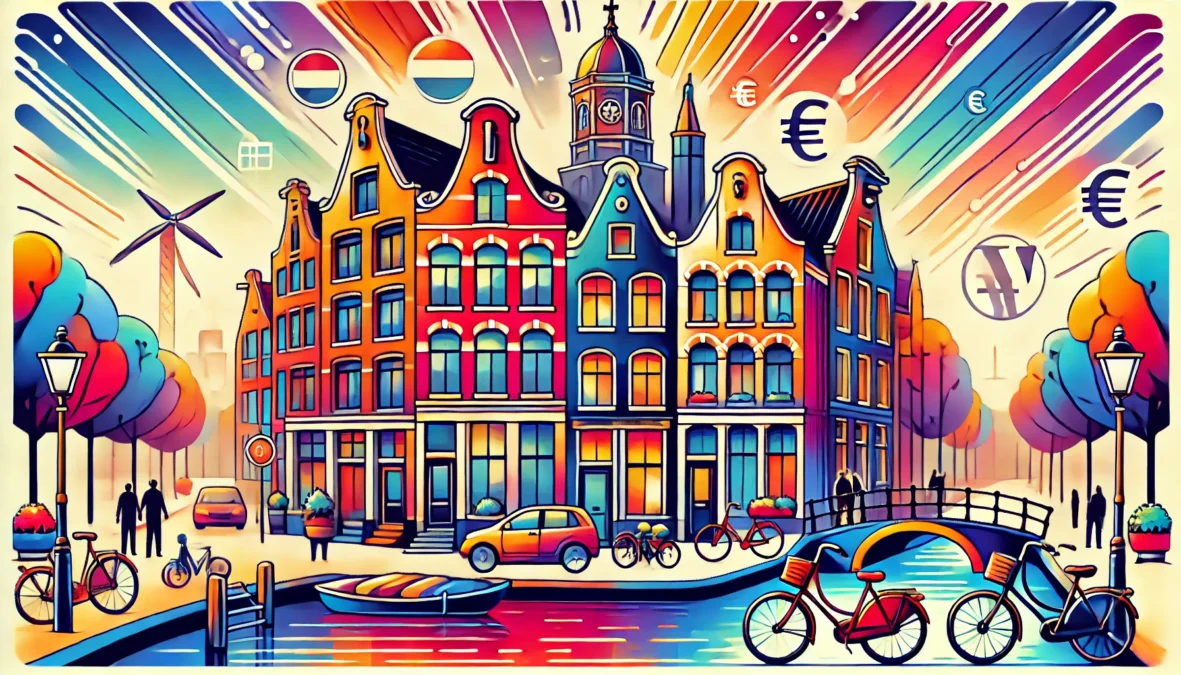Imagine you’re a young couple living in Amsterdam, dreaming of buying your first home. With rising prices and intense competition, you’ve been renting for years, and the housing market feels daunting. You begin exploring mortgage options and are surprised by the range of choices available—some quite different from traditional mortgages in other countries. You find yourself drawn to the unique structure of Dutch style mortgages, which offers flexibility in payments and even the potential for lower monthly costs. You wonder: Could this be the solution that allows you to make your homeownership dream a reality finally?
In the Netherlands, mortgages work differently than in many other countries, with innovative structures and options that appeal to first-time buyers and experienced homeowners. In this article, we’ll dive into the key features of Dutch style mortgages, explore how they differ from conventional mortgages in other countries, and examine why these options have become popular in the Netherlands.
What is a Dutch-style mortgage?
A Dutch-style mortgage is a distinctive type of home loan available in the Netherlands that offers different payment structures than the traditional fixed-rate mortgages commonly found in countries like the United States. Dutch mortgages are known for their flexibility, tax advantages, and innovative options, allowing homeowners to tailor their loans to fit their financial situations. Some common Dutch mortgage types include the interest-only mortgage, linear mortgage, annuity mortgage, and hybrid mortgage, each serving different financial needs and preferences.
One notable feature of the Dutch mortgage market is the mortgage interest deduction (hypotheekrenteaftrek), a tax incentive that allows homeowners to deduct their mortgage interest payments from their taxable income. This policy, unique to the Netherlands, makes homeownership more affordable and has historically encouraged higher homeownership rates.
Types of Dutch Mortgages
Let’s take a closer look at some of the popular Dutch mortgage types and their distinct features:
- Annuity Mortgage (Annuïteitenhypotheek)
- An annuity mortgage is one of the most common types of mortgages in the Netherlands. With this type of mortgage, monthly payments are fixed, but the composition of each payment changes over time. Initially, a larger portion of the payment goes toward interest; over time, more goes toward repaying the principal.
- This structure means that monthly payments remain the same, providing stability, but the interest payments gradually decrease, lowering the tax deduction over time. According to a 2021 report by the Dutch National Bank (DNB), more than 40% of Dutch homeowners have an annuity mortgage, making it the most popular mortgage type in the country.
- Linear Mortgage (Lineaire hypotheek)
- In a linear mortgage, borrowers pay a fixed amount toward the principal every month, while interest payments decrease over time as the loan balance reduces. This means that monthly payments are initially higher and gradually decrease, incentivizing homeowners who want to repay their loans faster.
- Linear mortgages are less common but are preferred by those who can afford higher initial payments. A 2020 study by the Dutch Mortgage Association showed that around 15% of Dutch mortgages are structured as linear, mostly among homeowners with higher income levels prioritizing paying down debt quickly.
- Interest-Only Mortgage (Aflossingsvrije hypotheek)
- With an interest-only mortgage, homeowners only pay the interest on the loan, meaning the principal remains unchanged unless voluntary payments are made. This results in lower monthly payments but requires the borrower to repay the principal at the end of the term or when the home is sold.
- Interest-only mortgages were very popular in the Netherlands in the early 2000s, but regulations tightened following the 2008 financial crisis. Now, interest-only mortgages are only available under certain conditions, and they’re generally recommended for older homeowners or those with other means to pay off the loan at the end of the term.
- According to the Netherlands Bureau for Economic Policy Analysis (CPB), about 30% of Dutch homeowners still have interest-only mortgages. However, new regulations have made it harder for first-time buyers to qualify for these loans.
- Hybrid Mortgages
- Hybrid mortgages combine elements of interest-only, annuity, and linear mortgages. They allow borrowers to switch between different repayment structures over time, providing flexibility based on changing financial circumstances. These mortgage types appeal to homeowners who may want a lower initial payment but plan to switch to higher payments later.
The Role of Mortgage Interest Deduction in Dutch Mortgages
One of the most significant incentives in the Dutch mortgage market is the mortgage interest deduction. This tax benefit allows homeowners to deduct their mortgage interest from their taxable income, which can substantially reduce their annual tax bill. For example, if a homeowner pays €5,000 in mortgage interest and falls in the 37% tax bracket, they can save €1,850 per year in taxes.
However, the Dutch government recently reduced the maximum mortgage interest deduction rate. As of 2023, the deduction is capped at 36.93% and is expected to decline further to create a more balanced housing market and reduce over-leveraging.
The mortgage interest deduction policy has encouraged homeownership and made it more affordable for middle-income households. However, critics argue it has also contributed to high home prices, as people can borrow larger amounts due to the tax benefits. This has led to debates on whether the mortgage interest deduction policy should be reformed further to improve housing affordability.
How Dutch Mortgages Differ from U.S. Mortgages
Dutch mortgages have some unique characteristics compared to other countries, especially the United States. Here are a few key differences:
- Flexible Repayment Structures
- In the Netherlands, borrowers have more flexibility with repayment structures, allowing them to choose between annuity, linear, interest-only, and hybrid mortgages. In the U.S., mortgages are typically fixed-rate or adjustable-rate loans, with less customization in payment structures.
- Mortgage Interest Deduction
- While mortgage interest deduction is available in the U.S., it is limited and often only applies to a certain portion of the interest paid. The mortgage interest deduction in the Netherlands has historically been more generous, although recent reforms are reducing its impact.
- Loan-to-Value Ratios
- The Netherlands has strict loan-to-value (LTV) regulations, limiting the amount borrowers can borrow relative to the property value. As of 2022, the maximum LTV in the Netherlands is 100%, meaning borrowers can only borrow up to the property’s purchase price. This differs from the U.S., where higher LTV ratios are often allowed, and down payments as low as 3% can be common.
- Emphasis on Affordability
- Dutch lenders must consider a borrower’s income and the potential impact of interest rate increases on monthly payments. This focus on affordability helps prevent over-borrowing and reduces financial risks for homeowners.
Current Trends in the Dutch Mortgage Market
The Dutch mortgage market has seen significant changes in recent years due to shifting government policies, economic conditions, and consumer preferences. Here are some current trends:
- Rising Interest Rates
- After years of historically low interest rates, the European Central Bank has gradually raised rates in response to inflation concerns. This has led to an increase in mortgage rates, which has impacted affordability for new buyers. According to the Dutch Association of Real Estate Agents (NVM), the average mortgage interest rate increased from 1.5% in early 2022 to over 3% by 2023.
- Increasing Demand for Green Mortgages
- Sustainability is a growing priority for Dutch homeowners. Green mortgages offer better terms or lower rates for energy-efficient homes and are becoming increasingly popular. In 2021, nearly 20% of new Dutch mortgages were green, according to a report by ABN AMRO, as buyers seek financial benefits and environmental impact.
- Growth of the Private Rental Sector
- High housing prices have made it difficult for some young people to enter the housing market, increasing demand for rental properties. However, the Dutch government is working to increase homeownership among young people through initiatives like deposit assistance and affordable housing projects.
Conclusion: The Future of Dutch Style Mortgages
Dutch style mortgages offer a range of options that provide flexibility, tax advantages, and affordability for Dutch homeowners. However, the market is evolving with rising interest rates and gradual cuts to mortgage interest deductions. The government’s focus on financial stability and sustainability will likely continue to shape the mortgage landscape in the Netherlands.
For first-time homebuyers and young families, understanding these mortgage options and the broader economic context is essential for making informed decisions. As the Dutch housing market adapts, prospective homeowners must weigh various mortgage types’ benefits and potential risks. In the meantime, the unique Dutch approach to home financing remains a fascinating model, combining innovation with a commitment to affordability and long-term stability.



